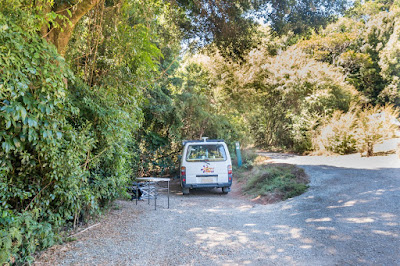 |
| Green Mountain Campground |
 |
| Tent area at Green Mountain Campground. |
 |
| Entrance to the Centenary Track from the day use car park. |
 |
| Campervan Site 10, next to the exit road. |
 |
| Amenities Block, Green Mountain Campground. |
 |
| Shower block, Green Mountain Campground. |
 |
| QPWS Information Centre. |
 |
| Inside the Information Centre. |
 |
| QPWS WiFi Hub at Green Mountain. |
 |
| Red-necked Pademelon. |
 |
| Eastern Water Skink |
 |
| Regent Bowerbird. |
 |
| Eastern Whipbird. |
 |
| Bassian Thrush. |
Details for Green Mountain Campground:
Where: 2 hours,114 km south of Brisbane via Canungra and Lamington National Park Road.
Access: Sealed roads. (Campground loop is gravel). Lamington National Park Road is not suitable for caravans, it is narrow, windy and has many one lane sections.
Fees & Bookings: $6.65 per adult per night. Bookings can be made online or by phone. I had 4 bar Telstra phone reception in the campground. There is a free QPWS WiFi hub next to the QPWS Visitor Information Centre opposite O'Reilly's Rainforest Resort. Book in advance for weekends and holidays. Maximum 21 nights.
Camping Type: Tents, campervans and small motorhomes. There are no sites for camper trailers, caravans, medium-large motorhomes, big rigs or camping beside your vehicle. No powered sites. Bush camping available from February to November.
Sites: 20 defined and numbered tent sites with hardened surface platforms, limited shade, car parking a short distance away, maximum 4 people per tent site. 10 small defined and numbered campervan sites, one vehicle only. Some campervan sites are suitable for roof-top tents. 10 Great Walk sites with maximum 2 tents per site.
Facilities: Several water taps, non-flush toilets, 1 disability toilet, gas heated hot showers, 1 table, industrial bin at top of campground next to campervan site 1. No camp shelter, camp kitchen or barbecues in campground. Access to walks. Telstra phone reception.
Picnic Area: Opposite O'Reilly's Rainforest Resort with hybrid toilets, electric barbecues and tables, some with shelter.
QPWS Information Centre and Free WiFi Hub: Just past the main carpark which is past the campground. Has free brochures and walking track information.
Prohibited: No open fires. No generators. No pets.
Note: Tent site and campervan site numbers overlap. If you have booked a campervan site look for the campervan symbol on the marker post.
O'Reilly's Rainforest Retreat: At the end of the road, past the campground. Cafe. Activities. Accommodation.
Wildlife: Red-legged Pademelon, Red-necked Pademelon, Eastern Water Skink. Butterflies: Black Jezebel, Blue Triangle, Monarch, Orchard Swallowtail. Birds: Regent Bowerbird, Satin Bowerbird, Australian Brush Turkey, Green Catbird, Sulphur-crested Cockatoo, Pied Currawong, Brown Cuckoo-Dove, Superb Fairy-wren, Rufous Fantail, Red-browed Finch, Wompoo Fruit-Dove, Brown Gerygone, Lewin's Honeyeater, Logrunner, Black-faced Monarch, White-throated Needletail, Striated Pardalote, Australian King Parrot, Paradise Riflebird, Eastern Yellow Robin, Rose Robin, Crimson Rosella, Large-billed Scrubwren, White-browed Scrubwren, Yellow-throated Scrubwren, Grey Shrike-thrush, Silvereye, Welcome Swallow, Brown Thornbill, Bassian Thrush, White-throated Treecreeper, Eastern Whipbird, Golden Whistler. Heard a colony of Bell Miners on Lamington National Park Road in Eucalypt Forest.
































